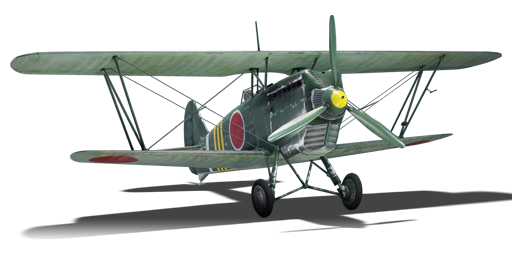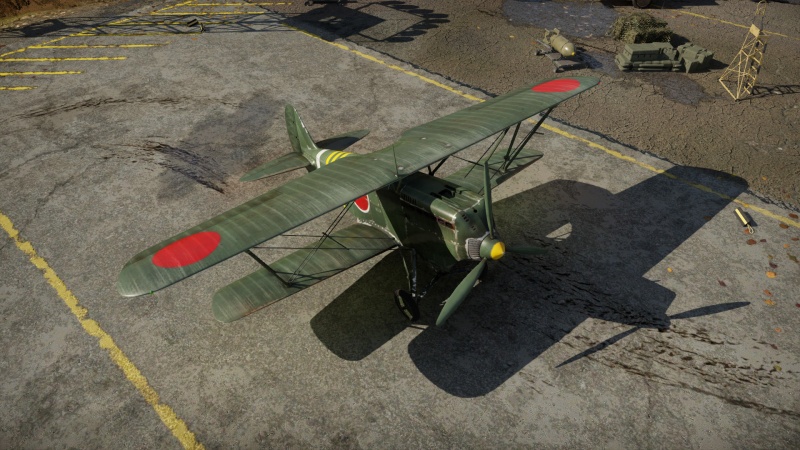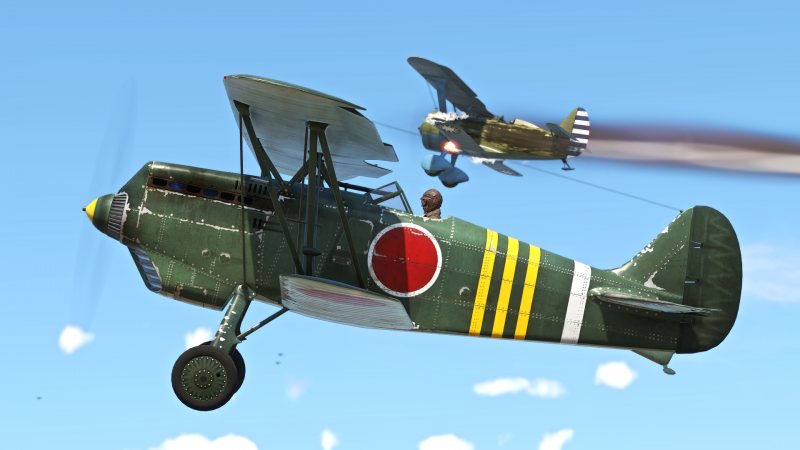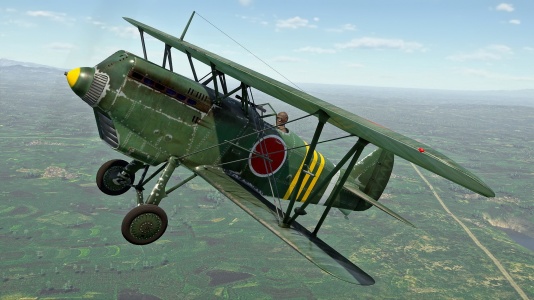Difference between revisions of "Ki-10-I C"
(→Pros and cons) (Tag: Visual edit) |
m |
||
| (7 intermediate revisions by 4 users not shown) | |||
| Line 6: | Line 6: | ||
{{Specs-Card | {{Specs-Card | ||
|code=ki_10_1_commander | |code=ki_10_1_commander | ||
| − | |images={{Specs-Card-Image|GarageImage_{{PAGENAME}}.jpg| | + | |images={{Specs-Card-Image|GarageImage_{{PAGENAME}}.jpg|ArtImage2_{{PAGENAME}}.png}} |
}} | }} | ||
== Description == | == Description == | ||
<!-- ''In the description, the first part should be about the history of and the creation and combat usage of the aircraft, as well as its key features. In the second part, tell the reader about the aircraft in the game. Insert a screenshot of the vehicle, so that if the novice player does not remember the vehicle by name, he will immediately understand what kind of vehicle the article is talking about.'' --> | <!-- ''In the description, the first part should be about the history of and the creation and combat usage of the aircraft, as well as its key features. In the second part, tell the reader about the aircraft in the game. Insert a screenshot of the vehicle, so that if the novice player does not remember the vehicle by name, he will immediately understand what kind of vehicle the article is talking about.'' --> | ||
| − | + | This '''Ki-10-I (Commander)''', designated as '''Type 95 Fighter ({{Annotation|九五式戦闘機|Kyū Go-shiki Sentōki}})''', was assigned to the 1st Hiko Sentai, which was established on July 5, 1938 as the first flying unit in the Japanese Army Air Service. The 1st Hiko Sentai operated the Ki-10-I until May 1942, when it switched to the Ki-27. The Ki-10-I was then retired to training and secondary missions. | |
| − | + | In the game since the start of the Open Beta Test prior to Update 1.27, the Ki-10-I C performs similarly to the other Ki-10s. It has a good turn rate, fair climb, low speed, and minimal armour. It is faster and climbs better than other biplanes, but has weaker guns and protection. The Ki-10-I can turn-fight well at low altitudes, but should avoid stalls and spins. Its 7.7 mm guns have low fire rate and poor belts. Stealth belt is the best choice. The Ki-10-I should not attack armoured targets or bombers, but focus on other biplanes or slow monoplanes. Aim for the wings, not the fuselage. Teamwork is essential for the Ki-10-I. | |
| − | + | ;Nicknames: | |
| − | + | * IJA Pilot Abbreviation: ''Kyū-Go Sen'' (九五戦, "9-5 Fighter") | |
| + | * Allied reporting name: Perry | ||
== General info == | == General info == | ||
| Line 153: | Line 154: | ||
'''Cons:''' | '''Cons:''' | ||
| − | * | + | * Weak armour |
* Poor diving ability | * Poor diving ability | ||
* Poor spin characteristics | * Poor spin characteristics | ||
| Line 159: | Line 160: | ||
== History == | == History == | ||
<!-- ''Describe the history of the creation and combat usage of the aircraft in more detail than in the introduction. If the historical reference turns out to be too long, take it to a separate article, taking a link to the article about the vehicle and adding a block "/History" (example: <nowiki>https://wiki.warthunder.com/(Vehicle-name)/History</nowiki>) and add a link to it here using the <code>main</code> template. Be sure to reference text and sources by using <code><nowiki><ref></ref></nowiki></code>, as well as adding them at the end of the article with <code><nowiki><references /></nowiki></code>. This section may also include the vehicle's dev blog entry (if applicable) and the in-game encyclopedia description (under <code><nowiki>=== In-game description ===</nowiki></code>, also if applicable).'' --> | <!-- ''Describe the history of the creation and combat usage of the aircraft in more detail than in the introduction. If the historical reference turns out to be too long, take it to a separate article, taking a link to the article about the vehicle and adding a block "/History" (example: <nowiki>https://wiki.warthunder.com/(Vehicle-name)/History</nowiki>) and add a link to it here using the <code>main</code> template. Be sure to reference text and sources by using <code><nowiki><ref></ref></nowiki></code>, as well as adding them at the end of the article with <code><nowiki><references /></nowiki></code>. This section may also include the vehicle's dev blog entry (if applicable) and the in-game encyclopedia description (under <code><nowiki>=== In-game description ===</nowiki></code>, also if applicable).'' --> | ||
| − | The Kawasaki Ki-10 was the last Biplane fighter used by the Japanese Army. Introduced in 1935, it beat the competing Nakajima Ki-11 (which would later be refined as the [[Ki-27 otsu|Ki-27]]) as the Imperial Japanese Army Air | + | The Kawasaki Ki-10 was the last Biplane fighter used by the Japanese Army. Introduced in 1935, it beat the competing Nakajima Ki-11 (which would later be refined as the [[Ki-27 otsu|Ki-27]]) as the Imperial Japanese Army Air Service placed more priority on manoeuvrability than speed. Its excellent manoeuvrability made it extremely popular with Japanese pilots, who demanded similar high manoeuvrability from newer aircraft. Over the course of its service, the fighter would be refined several times with the ultimate version, the [[Ki-10-II]], appearing in 1937. |
| − | The Ki-10 saw service against Chinese air forces in the early stages of the Second Sino-Japanese War and against Soviet air forces during the battles of Khalkhin Gol (where it historically outperformed the Soviet [[I-15 M-22|I-15]]). It formed the backbone of the | + | The Ki-10 saw service against Chinese air forces in the early stages of the Second Sino-Japanese War and against Soviet air forces during the battles of Khalkhin Gol (where it historically outperformed the Soviet [[I-15 M-22|I-15]]). It formed the backbone of the IJAAS fighter forces until 1940, but it was considered obsolete by Western military experts as early as 1938. By the start of the Pacific War, the Ki-10 had been regulated to training and courier roles, and received the Allied reporting name "Perry". |
There are no known incidents where the Ki-10 engaged American- or British-crewed aircraft, though the Japanese fighter did fight Chinese National [[P-26A-33|P-26s]], and may have engaged British-built [[Gladiator Mk II|Gladiators]], Italian [[CR.32]]s, and Soviet [[I-15bis|I-15s]], all crewed by Chinese pilots, during the early battles of the war. | There are no known incidents where the Ki-10 engaged American- or British-crewed aircraft, though the Japanese fighter did fight Chinese National [[P-26A-33|P-26s]], and may have engaged British-built [[Gladiator Mk II|Gladiators]], Italian [[CR.32]]s, and Soviet [[I-15bis|I-15s]], all crewed by Chinese pilots, during the early battles of the war. | ||
| Line 189: | Line 190: | ||
== Media == | == Media == | ||
<!-- ''Excellent additions to the article would be video guides, screenshots from the game, and photos.'' --> | <!-- ''Excellent additions to the article would be video guides, screenshots from the game, and photos.'' --> | ||
| + | |||
| + | ;Images | ||
| + | <gallery mode="packed-hover" heights="200"> | ||
| + | File:ArtImage Ki-10-I C.jpg | ||
| + | </gallery> | ||
;Skins | ;Skins | ||
| − | |||
* [https://live.warthunder.com/feed/camouflages/?vehicle=ki_10_1_commander Skins and camouflages for the {{PAGENAME}} from live.warthunder.com.] | * [https://live.warthunder.com/feed/camouflages/?vehicle=ki_10_1_commander Skins and camouflages for the {{PAGENAME}} from live.warthunder.com.] | ||
Latest revision as of 07:30, 28 August 2024
| This page is about the Japanese fighter Ki-10-I C. For other variants, see Ki-10 (Family). |
Contents
Description
This Ki-10-I (Commander), designated as Type 95 Fighter (九五式戦闘機), was assigned to the 1st Hiko Sentai, which was established on July 5, 1938 as the first flying unit in the Japanese Army Air Service. The 1st Hiko Sentai operated the Ki-10-I until May 1942, when it switched to the Ki-27. The Ki-10-I was then retired to training and secondary missions.
In the game since the start of the Open Beta Test prior to Update 1.27, the Ki-10-I C performs similarly to the other Ki-10s. It has a good turn rate, fair climb, low speed, and minimal armour. It is faster and climbs better than other biplanes, but has weaker guns and protection. The Ki-10-I can turn-fight well at low altitudes, but should avoid stalls and spins. Its 7.7 mm guns have low fire rate and poor belts. Stealth belt is the best choice. The Ki-10-I should not attack armoured targets or bombers, but focus on other biplanes or slow monoplanes. Aim for the wings, not the fuselage. Teamwork is essential for the Ki-10-I.
- Nicknames
- IJA Pilot Abbreviation: Kyū-Go Sen (九五戦, "9-5 Fighter")
- Allied reporting name: Perry
General info
Flight performance
| Characteristics | Max Speed (km/h at 4,000 m) |
Max altitude (metres) |
Turn time (seconds) |
Rate of climb (metres/second) |
Take-off run (metres) | |||
|---|---|---|---|---|---|---|---|---|
| AB | RB | AB | RB | AB | RB | |||
| Stock | 386 | 373 | 8100 | 16.4 | 17.2 | 10.9 | 10.9 | 232 |
| Upgraded | 422 | 402 | 15.8 | 16.0 | 22.2 | 15.7 | ||
Details
| Features | ||||
|---|---|---|---|---|
| Combat flaps | Take-off flaps | Landing flaps | Air brakes | Arrestor gear |
| X | X | X | X | X |
| Limits | ||||||
|---|---|---|---|---|---|---|
| Wings (km/h) | Gear (km/h) | Flaps (km/h) | Max Static G | |||
| Combat | Take-off | Landing | + | - | ||
| 600 | 560 | N/A | N/A | N/A | ~11 | ~6 |
| Optimal velocities (km/h) | |||
|---|---|---|---|
| Ailerons | Rudder | Elevators | Radiator |
| < 280 | < 350 | < 320 | > 190 |
| Compressor (RB/SB) | ||
|---|---|---|
| Setting 1 | ||
| Optimal altitude | 100% Engine power | WEP Engine power |
| 3,500 m | 800 hp | 944 hp |
Survivability and armour
- No armour plating
- No armour glazing
- All critical components located in front of aircraft (fuel, pilot, engine, controls)
Like many biplanes before and contemporaries of the Ki-10-I C, armour was not an option, survival was based on the pilot's grit. Armour added weight, weight the early biplanes could not afford to carry and still be a viable fighter. Flying in open cockpit and fabric-covered aircraft, the only protection the pilot had was to place his engine between him and his enemy, otherwise, the pilot was vulnerable. Typically aircraft like this have the engine at the nose of the aircraft, followed by the fuel tank and then the cockpit, all three critical components relatively crammed together. The pilot's toolbox had to contain situational awareness as he needed to know where the enemy was around him. Tracer rounds could easily ignite the fabric-covered aircraft or large fuel tanks, so it was imperative the pilot was the attacker, not the one being attacked and knowing where the enemies are at can help avoid getting shot at.
Modifications and economy
For such low-rank vehicles the order of research does not really matter. Improvements in firepower by new belts and new machine guns help a lot in Arcade Battles. For Realistic mode, performance upgrades are more often necessary.
Armaments
Offensive armament
The Ki-10-I C is armed with:
- 2 x 7.7 mm Type 89 machine guns, nose-mounted (450 rpg = 900 total)
Usage in battles
The Ki-10-I's low speed and tight turning ability make it a great turn-fighter, like most Japanese light fighters. The Ki-10-I excels at low and slow turn fighting at very low altitudes where enemies cannot out-dive it. Additionally, it has a climb rate to climb away from enemy biplanes. Very fast dives should be avoided, as the wings will shear off at very high speeds. Similarly, turning stalls should be avoided, as the Ki-10-I has a tendency to enter uncontrollable spins.
Its twin 7.7 mm armament is the weakest in the game, as it has a lower fire rate than its contemporaries, the ShKAS, Browning, and MG 17. The belts are poor as well; Stealth is most recommended, as it has the most AP-derivative shells. Strafing attacks on all but the least armoured targets are not recommended; Artillery, Vehicles, and Landing Craft are good and soft targets, while the Ki-10-I's weak construction makes attacking AAA and bombers risky. All bombers are pretty much invulnerable to the Ki-10-I (Beaufort, A-26, etc.) unless you are extremely good at making consistent pilot shots. Cargo Ships, Tanks and pillboxes are also invulnerable to the Ki-10-I. Instead, the best Ki-10-I targets are other biplanes or slow monoplanes, such as P-26s, Fury Mk Is or Nimrod Mk Is. The best practice is to aim for the wings! The fuselage's of all planes will absorb your shells like a sponge. Like most other planes, the Ki-10-I works best in numbers. Ki-10 pilots should focus primarily on sticking together and working as a team.
Manual Engine Control
| MEC elements | ||||||
|---|---|---|---|---|---|---|
| Mixer | Pitch | Radiator | Supercharger | Turbocharger | ||
| Oil | Water | Type | ||||
| Not controllable | Not controllable Not auto controlled |
Not controllable Not auto controlled |
Controllable Not auto controlled |
Combined | Not controllable 1 gear |
Not controllable |
Pros and cons
Pros:
- Great manoeuvrability
- Low stall speed
- Fast top speed for a biplane
- Good climb rate for a biplane
Cons:
- Weak armour
- Poor diving ability
- Poor spin characteristics
History
The Kawasaki Ki-10 was the last Biplane fighter used by the Japanese Army. Introduced in 1935, it beat the competing Nakajima Ki-11 (which would later be refined as the Ki-27) as the Imperial Japanese Army Air Service placed more priority on manoeuvrability than speed. Its excellent manoeuvrability made it extremely popular with Japanese pilots, who demanded similar high manoeuvrability from newer aircraft. Over the course of its service, the fighter would be refined several times with the ultimate version, the Ki-10-II, appearing in 1937.
The Ki-10 saw service against Chinese air forces in the early stages of the Second Sino-Japanese War and against Soviet air forces during the battles of Khalkhin Gol (where it historically outperformed the Soviet I-15). It formed the backbone of the IJAAS fighter forces until 1940, but it was considered obsolete by Western military experts as early as 1938. By the start of the Pacific War, the Ki-10 had been regulated to training and courier roles, and received the Allied reporting name "Perry".
There are no known incidents where the Ki-10 engaged American- or British-crewed aircraft, though the Japanese fighter did fight Chinese National P-26s, and may have engaged British-built Gladiators, Italian CR.32s, and Soviet I-15s, all crewed by Chinese pilots, during the early battles of the war.
| Archive of the in-game description | |
|---|---|
|
Kawasaki Ki-10-I (Type 95-I, Allied reporting name: Perry) single-engine army fighter A biplane of composite structure with non-retractable landing gear and an open cockpit. This plane was created in the design bureau of Kawasaki Heavy Industries under the direction of Takeo Doi. While the new fighter was being designed, experience and structural solutions were used from the Ki-5 monoplane fighter developed earlier. The designers, headed by Takeo Doi, managed to create quite a successful aircraft with good flight performance. The Type 95 fighter got off the ground for the first time in February 1935, and it reached a maximum speed of 400 km/h during tests. At the time, this was probably the fastest speed attainable by a biplane. The aircraft was launched into full-scale production under the designation of "Army Fighter Type 95 Model 1" (Ki-10-I). A total of 300 fighters of this variant were supplied by the Kawasaki company from December 1935 to October 1937. The aircraft was equipped with a 850 hp Kawasaki Ha-9-IIa twelve-cylinder, double-row, liquid-cooled engine that featured a gear-driven centrifugal-type supercharger and a three-bladed, controllable-pitch metal propeller. The engine itself was a licensed version of the German BMW9. The Ki-10's fuselage was a semi-monocoque with stressed duralumin skin panels overlapping each other. This technology made assembly easier, but the joints had to be puttied and covered with a thick layer of paint and lacquer to reduce friction resistance. As a result, the external finish was so thick that one could not see any of the duralumin sheets' joints, even when standing quite close. All of these machines were produced with drop-shaped wheel fairings, but these were usually removed when the plane was operated on temporary airfields. The plane's armament consisted of two synchronous 7.7 mm Type 89 (Vickers system, heavily upgraded) machine guns with 450 rounds each. These guns were mounted over the engine. The trigger button was placed in a very original location, not on the aircraft control stick but on the throttle. The aircraft's instrumentation and on-board navigation lights enabled the Ki-10 to perform night flights. Provision was made for the installation of an oxygen apparatus. Command vehicles were equipped with radio sets. Externally, these fighters could be identified by the radio antennas mounted over their biplane cellules. | |
Media
- Images
- Skins
- Videos
See also
- Ki-10-I
- Ki-10-II
- Ki-10-II Commander - Command plane of the 77th Sentai
- Planes of comparable role, configuration and era
External links
| Kawasaki Aircraft Industries (川崎航空機工業株式会社) | |
|---|---|
| Biplane Fighters | Ki-10-I · Ki-10-I C · Ki-10-II · Ki-10-II C |
| Fighters | Ki-61-I ko · Ki-61-I otsu · Ki-61-I hei · Tada's Ki-61-I hei · Ki-61-I tei · Ki-61-II Otsu Kai |
| Ki-100 · Ki-100-II | |
| Interceptors | Ki-45 ko · Ki-45 otsu · Ki-45 hei · Ki-45 tei |
| Ki-96 | |
| Ki-102 otsu | |
| Ki-108 Kai | |
| Bombers | Ki-32 |
| Ki-48-II otsu | |
| Captured | ␗Ki-45 hei/tei · ␗Ki-61-I otsu · ▃Ki-61-Ib |
| See also | Kawasaki Shipyard Co. |
| Japan fighters | |
|---|---|
| Navy | |
| Carrier-based fighter | |
| A5M | A5M4 · Hagiri's A5M4 |
| A6M | A6M2 mod. 11 · A6M2 · A6M3 · A6M3 mod. 22 · A6M3 mod. 22Ko · A6M5 · A6M5 Ko · A6M5 otsu · A6M5 Hei · A6M6c |
| A7He | A7He1* |
| A7M | A7M1 (NK9H) · A7M2 |
| Land-based Fighter | |
| J2M | J2M2 · J2M3 · J2M4 Kai · J2M5 · J2M5 (30 mm) |
| J6K | J6K1 |
| J7W | J7W1 |
| N1K-J | N1K1-Ja · N1K2-J · N1K2-Ja |
| Fighter seaplane | |
| N1K | N1K1 |
| A6M-N | A6M2-N |
| Army | |
| Ki-10 | Ki-10-I · Ki-10-I C · Ki-10-II · Ki-10-II C |
| Ki-27 | Ki-27 otsu · Ki-27 otsu Tachiarai |
| Ki-43 | Ki-43-I · Ki-43-II · Ki-43-III otsu |
| Ki-44 | Ki-44-I · Ki-44-I 34 · Ki-44-II otsu · Ki-44-II hei |
| Ki-61 | Ki-61-I ko · Ki-61-I otsu · Ki-61-I hei · Tada's Ki-61-I hei · Ki-61-I tei · Ki-61-II Otsu Kai |
| Ki-84 | Ki-84 ko · Ki-84 otsu · Ki-84 hei |
| Ki-87 | Ki-87 |
| Ki-94 | Ki-94-II |
| Ki-100 | Ki-100 · Ki-100-II |
| Other countries | ▅F4U-1A · ▅P-51C-11-NT · ▅Bf 109 E-7 · ▅Fw 190 A-5 |
| *Imported designation of the He 112 (A6M was in development - A7M would take A7 designation after the cancelation of the A7He) | |







